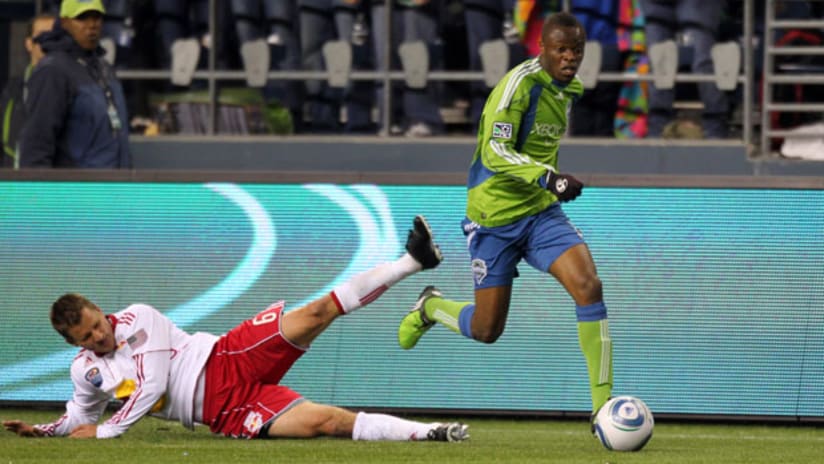The day of the classic winger is over, kind of like New Coke. No longer can a tricky dribbling specialist be content to hug the touchline waiting for chances to beat his man and swerve pretty crosses.
They still do that at times, sure, but the modern game of organized defenses demands so much more. So the men who attack from wide areas must be complete players—or something close to it.
Take Seattle’s Steve Zakuani. Last year, the overall number one draft pick was a blur of pace who ran at defenders from his spot on the left at Qwest, although his game sometimes lacked nuance. In just a year he has added significantly to his stores of wile. With added physical presence, an ability to win the ball in midfield and knowledge on when to maneuver inside, he has become even more dangerous.
He was having a relatively quite night against Dallas last week (as FCD wide midfielder Atiba Harris focused less on offense and more on helping defend Zakuani). But one well-timed burst down the left side brought the important equalizer. Would last year’s Zakuani have recognized and exploited the moment when FCD fullback Zach Loyd got caught too far forward without cover?
Houston veteran Brad Davis is another premier MLS left-sider, ever comfortable coming inside. He is doing even more of it this year. Houston are missing a couple of its signature big strikers, so banging balls willy-nilly into the penalty area just won’t do. Instead, Davis drifts inside regularly to assist Geoff Cameron, who was just learning to work the top of Houston’s diamond-shaped midfield when his knee betrayed him so sadly.
Davis is a good example of today’s two-way flank midfielder, a worker bee able to slant inside on offense and willing to share the defensive load. They don’t have to specialize in blue-collar defensive work, a la Houston’s Brian Mullan or Real Salt Lake’s Will Johnson, but they certainly must help.
Speedy New England attacker Sainey Nyassi was on a short list of Revs who had a good night against Colorado. Nyassi whipped in several dangerous balls from the right toward forwards Zack Schilawski and Kheli Dube. While he looks to get the most of his speed, he knows when to hit early balls, too, serving before the second man arrived on defense.
His more comprehensive body of work helped create the Revs’ only goal. Nyassi dribbled at top speed into the offensive third, serving a useful ball to the back post before the defense could fully organize. Colorado managed a scrambling clearance, but Nyassi moved quickly inside to recover the ball.
After he did, Pablo Mastroeni chose to foul rather than chase Nyassi’s next run off the ball. Then, Marko Perovic made the free kick count.
Speed isn’t necessarily essential, though. In second-half relief duty, L.A. reservist Chris Klein reminded us how some guys find room to serve through shrewd timing and an ability to read the game. Meanwhile others do it with technical craft. Columbus Crew winger Eddie Gaven isn’t particularly quick, but he knows his angles that he needs just a smidge of space to deliver a cross.
The wide midfielder who can’t threaten to cut inside is too predictable and, therefore, too easily neutralized. San Jose’s Arturo Alvarez frequently plays on the right, and despite everybody knowing he wants to cut inside and use his left foot, he still pulls it off. Only an organized defense with lots of inside help and communication can deal with it. Young Philadelphia man Roger Torres has a lot of that in him, too. So does Chicago’s Marco Pappa (although he’s playing centrally right now in Carlos de los Cobos’ 4-5-1).
MLS does have a few men who look something like the classic wingers of bygone day. Robbie Rogers works the left at Crew Stadium with a destabilizing speed. Sigi Schmid previously and current Crew manager Robert Warzycha have attempted to work with Rogers, tutoring him on making the best choices: when to run at defenders, when to take one touch past them into space and when to patiently hold possession and look to combine with Guillermo Barros Schelotto.
Rogers is also a good example of where MLS remains a work in progress quality-wise. He has the foot speed to reach great spots but can’t always deliver crosses with intent and authority. In MLS, there’s a lot of that going around. (FYI: Rogers’ run from a wide spot in the penalty area created the critical PK in the weekend win over Real Salt Lake.)
Wing play in modern soccer doesn’t just mean forwards and midfielders, of course. Teams depend on fullbacks to push ahead and supply width in attack. No team does this better than RSL, where the wide midfielders squeeze in liberally and depend on fullbacks to work the wide channels.
We know less about a couple of new wide guys in MLS. Kansas City’s Ryan Smith certainly has something to offer the left side of CommunityAmerica Ballpark. And K.C.’s 4-3-3 will provide opportunities to be isolated one-on-one, especially when they travel and get on the bigger fields.
Lastly, we got our first peak Saturday at Brian Nielsen, Red Bull’s new Danish winger. He didn’t see much of the ball against Philadelphia and he was coming off an illness. But he appears to have some power and pace. If he can prove a danger, Red Bull will really stretch defenses horizontally, with Nielsen on the left and Dane Richards working the right. That wide push is important to the way Red Bull want to play, with two centrally stationed midfielders but no true playmaker.
So far, it seems to be working.


